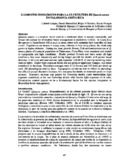Elementos fenológicos para la silvicultura de Quassia amara en Talamanca, Costa Rica
Resumen
Quassia amara is a tropical shrub used as a medicinal plant or natural insecticide, and whose silviculture for diversified forest management is studied by CATIE. In Costa Rica the species is found below 450 m.a.s.l. in areas where soils maintain their humidity all year round. Populations are denser in sunny areas, whereas in very rainy places, the shrub only grows at higher altitudes. During one year, growth, flower, fruit and seed production of Q. amara plants of a natural population in Talamanca, Costa Rica, were measured and related to topographic and light conditions. Shrubs produce flowers and fruits under all light conditions, but more intensively and during longer periods for shrubs with greater basal diameter (> 65 mm) and intermediate light exposure (20-80 percent of tree top receiving direct vertical light). Higher light exposure levels did not produce significant changes, but rather a tendency to decrease. Maximum averages were 1112 flowers and 135 fruits per shrub up until 180 phenological activity days. Topographic conditions had no effect on phenology but affected annual diametric increase; this was great for shrubs on mountain peaks or slope terraces. Diametric increase was greater for flowering shrubs under intermediate light exposure conditions or for non flowering shrubs with maximum light exposure (4.14 mm). Illumination control appears to be a fundamental factor for the species integration in diversified forest management.
Palabras clave
Editor
CATIE
Es parte de
Semana Científica;4
URI (Enlace permanente para citar o compartir este ítem)
https://repositorio.catie.ac.cr/handle/11554/7040Colecciones
- Publicaciones y documentos [4421]


